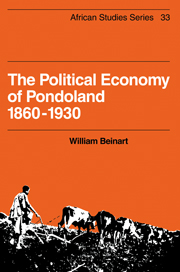Book contents
- Frontmatter
- Contents
- List of maps
- Preface
- Abbreviations
- Introduction
- 1 The political economy of Pondoland in the nineteenth century
- 2 Crops, cattle and the origins of labour migrancy, 1894–1911
- 3 Rural production and the South African state, 1911–1930
- 4 Chiefs and headmen in Pondoland, 1905–1930
- 5 Rural differentiation, alliance and conflict, 1910–1930
- Postscript
- Tables
- Notes
- Select bibliography
- Index
- BOOKS IN THIS SERIES
- Frontmatter
- Contents
- List of maps
- Preface
- Abbreviations
- Introduction
- 1 The political economy of Pondoland in the nineteenth century
- 2 Crops, cattle and the origins of labour migrancy, 1894–1911
- 3 Rural production and the South African state, 1911–1930
- 4 Chiefs and headmen in Pondoland, 1905–1930
- 5 Rural differentiation, alliance and conflict, 1910–1930
- Postscript
- Tables
- Notes
- Select bibliography
- Index
- BOOKS IN THIS SERIES
Summary
In the 1860s, the point at which this analysis begins, the region that was to become South Africa had already been deeply affected by successive waves of European expansion over two centuries. Each of the four settler states, the Cape, Natal and the Boer Republics, had conquered, displaced or incorporated some African societies and, except in the case of the Transvaal, had established a reasonably secure hegemony within its effective boundary. Yet the impact of colonisation was uneven. Between the settler states and to their north, a number of African polities remained, by reason of their power and size or by reason of their geographic position in relation to the thrust of settler expansion, relatively free from colonial control. The Zulu, Swazi, Sotho, Tswana and Pedi chiefdoms, as well as some of those which lay along the coast between the Cape and Natal, all forged to a greater or lesser degree in the indigenous revolution precipitated by the Mfecane, were by no means immune from penetration by the agents of metropolitan and colonial merchant and religious enterprise. Yet despite the gradual consolidation of imperial and settler power in the region, they were able to defend their political and economic independence with some success.
In the next seventy years, however, the period covered by this book, the region as a whole was deeply transformed by a rapid and far-reaching industrial revolution based initially on the mining of diamonds and gold. The exploitation of minerals heralded a new phase of metropolitan investment and intervention; the pace of accumulation within the colonies quickened.
- Type
- Chapter
- Information
- The Political Economy of Pondoland 1860–1930 , pp. 1 - 8Publisher: Cambridge University PressPrint publication year: 1982

